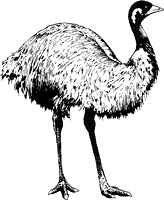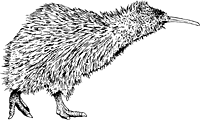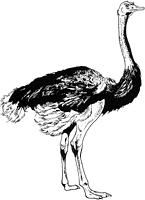Ask your average paleontologist who is familiar with the phylogeny of vertebrates and they will probably tell you that yes, birds (avians) are dinosaurs. Using proper terminology, birds are avian dinosaurs; other dinosaurs are non-avian dinosaurs, and (strange as it may sound) birds are technically considered reptiles. Overly technical? Just semantics? Perhaps, but still good science. In fact, the evidence is overwhelmingly in favor of birds being the descendants of a maniraptoran dinosaur, probably something similar (but not identical) to a small dromaeosaur. What is this evidence?

Emu
|
We'll spare you the exhaustive amount of available cladistic studies; those alone would make a large book if compiled. Dr. Jacques Gauthier, during his time as a graduate student of Professor Kevin Padian here at Berkeley, did his dissertation research on this subject, creating the first well accepted, detailed phylogeny of the diapsids. His work provided strong, compelling support for the theory that birds are theropod dinosaurs.
If we look back into the history of the issue, it is apparent that many comparative anatomists during the 16th through 19th centuries noticed that birds were very similar to traditional reptiles. In 1860, shortly after the publication of Charles Darwin's influential work On the Origin of Species By Means of Natural Selection, a quarry worker in Germany spotted an unusual fossil in the limestone of the Solnhofen Formation (late Jurassic period). This fossil turned out to be the famous 'London specimen' of Archaeopteryx lithographica. It was a beautiful example of a "transitional form" between two vertebrate groups (traditional reptiles and birds); just what Darwin expected would eventually be found. Archaeopteryx, generally accepted as being the oldest known bird, is an important link between birds and other coelurosaurs that has helped to illuminate the evolutionary history (phylogeny) of the group. It is now widely held to be the ancestor of all living birds; this is a common misconception. In fact, recent expeditions in China, Mongolia, Madagascar, Argentina, and elsewhere may uncover dinosaurs that usurp the "urvogel" status of Archaeopteryx.
Many scientists, including Thomas Henry Huxley (a staunch supporter of Darwin), saw incredible similarities between birds and the theropod dinosaurs (especially the coelurosaurs). Others since Huxley also hinted at the striking resemblances. However, birds were still not well accepted as dinosaur descendants — such hypotheses as A. Walker's "crocodylomorph" ancestor and G. Heilman's "thecodont" ancestor held sway for most of the 19th and 20th century, or else birds were simply dismissed as originating from some unknown reptile that didn't matter anyway. That would change. Dr. J.H. Ostrom's 1969 description of Deinonychus antirrhopus and its similarities to Archaeopteryx was the major step: his work since the 1970's has provided the impetus for a paradigm shift in paleontologists' visions of the origin of birds and the evolution of flight. Dr. Gauthier's cladistic work in the mid-1980's provided the best analytical systematic support for the theory that birds are the descendants of dinosaurs. Several independent analyses by other scientists have repeatedly upheld Gauthier's results. Today the important issue seems to be specifically which dinosaurs are the closest relatives of birds. The controversy over the dinosaurian status of birds had its heyday in the 1970's, but the coverage of the issue today by the press might make you think it was still a problematic matter. For those that have actually seen the relevant specimens and considered all of the relevant data (which is a basic procedure for any scientist), it is becoming increasingly difficult to draw the line between "bird" and "non-avian dinosaur".

Kiwi
|
Some researchers today do not agree that dinosaurs gave rise to birds, and are working to falsify this theory, but so far the evidence for the theory has swamped their efforts. If they were to conclusively establish that birds are more likely descended from another group (Crocodylomorpha, the group containing crocodiles, has been suggested), that would be a major upheaval in our knowledge of phylogeny. One single well-preserved fossil bird unequivocably of Triassic age might shed some doubt on the theory of the maniraptoran affinities of birds. That would be a major find. Some bird-like fossils have been presented as Triassic birds, but so far have not held up under peer review. Such is the dynamic nature of science.

Ostrich
|
So you may be thinking now, what are these striking resemblances between birds and other dinosaurs? The ratite birds, three of which are pictured in this article, are quite similar to theropod dinosaurs. Some of the similarities may be superficial, but others may be too obvious to dismiss, and in any case all available data must be considered. We'll start with the "reptilian" similarities of birds. Like all other reptiles, birds have scales (feathers are produced by tissues similar to those that produce scales, and birds have scales on their feet). Also, birds lay eggs like other reptiles. The soft anatomy (musculature, brain, heart, and other organs) all are fairly similar; birds are more derived in some aspects owing partially to theirendothermic metabolism and their ability to fly. There are numerous skeletal resemblances between birds and other reptiles; these form the basis of the cladistic analyses done by Gauthier and others.
Coelurosaurian dinosaurs are thought to be the closest relatives of birds, in fact, birds are considered to be coelurosaurs. This is based on Gauthier's and others' cladistic analyses of the skeletal morphology of these animals. Bones are used because bones are normally the only features preserved in the fossil record. The first birds shared the following major skeletal characteristics with many coelurosaurian dinosaurs (especially those of their own clade, the Maniraptora, which includes Velociraptor):
- Pubis (one of the three bones making up the vertebrate pelvis) shifted from an anterior to a more posterior orientation (see Saurischia), and bearing a small distal "boot".
- Elongated arms and forelimbs and clawed manus (hands).
- Large orbits (eye openings in the skull).
- Flexible wrist with a semi-lunate carpal (wrist bone).
- Hollow, thin-walled bones.
- 3-fingered opposable grasping manus (hand), 4-toed pes (foot); but supported by 3 main toes.
- Reduced, posteriorly stiffened tail.
- Elongated metatarsals (bones of the feet between the ankle and toes).
- S-shaped curved neck.
- Erect, digitgrade (ankle held well off the ground) stance with feet postitioned directly below the body.
- Similar eggshell microstructure.
- Teeth with a constriction between the root and the crown.
- Functional basis for wing power stroke present in arms and pectoral girdle (during motion, the arms were swung down and forward, then up and backwards, describing a "figure-eight" when viewed laterally).
- Expanded pneumatic sinuses in the skull.
- Five or more vertebrae incorporated into the sacrum (hip).
- Straplike scapula (shoulder blade).
- Clavicles (collarbone) fused to form a furcula (wishbone).
- Hingelike ankle joint, with movement mostly restricted to the fore-aft plane.
- Secondary bony palate (nostrils open posteriorly in throat).
- Possibly feathers... this awaits more study. Small, possibly feathered dinosaurs were recently found in China. It appears that many coelurosaurs were cloaked in an external fibrous covering that could be called "protofeathers."
Objections to the theory of the dinosaurian origin of birds
Some researchcers have raised issues that may seem to make the theropod origin of birds difficult to support, but these difficulties are more illusory than substantial. One proposed difficulty is the gap in the fossil record between the first known bird (Late Jurassic) and the dromaeosaurs, probable sister group of birds (Early Cretaceous). This overlooks the blatant fact that other maniraptoran coelurosaurs, such as Ornitholestes,Coelurus, and Compsognathus, are known from strata of Late Jurassic age. If other maniraptorans were there, it logically follows that the ancestors of dromaeosaurs were there. Fragmentary remains of possible dromaeosaurs are also known from the Late Jurassic.
Other arguments, such as the putative differences between theropod and bird finger development, or lung morphology, or ankle bone morphology, all stumble on the lack of relevant data on extinct theropods, misinterpretations of anatomy, simplifying assumptions about developmental flexibility, and/or speculations about convergence, biomechanics, or selective pressures. The opponents of the theropod hypothesis refuse to propose an alternative hypothesis that is falsifiable. This is probably because there are no other suitable candidates for avian ancestors. "Thecodonts" are often promoted as such, but this is an obfuscatory, antiquated term for a hodgepodge of poorly understood and paraphyletic, undiagnosible reptiles. The problems cited by such opponents for theropods are often more serious for the "thecodont" pseudo-hypothesis. Finally, such opponents also refuse to use the methods and evidence normally accepted by comparative evolutionary biologists, such as phylogenetic systematics and parsimony. They rely more on an "intuitive approach," which is not a method at all but just an untestable gestalt impression laden with assumptions about how evolution must work.
The "controversy" remains an interest more of the press than the general scientific community. There are more interesting issues for scientists to explore, such as how flight performance changed in birds, what the earliest function(s) of feathers was(were), when endothermy arose in some archosaurs, which group of theropods was ancestral to birds, how theropod ecology changed with the acquisition of flight, why some bird groups survived the Cretaceous extinction of other dinosaurs, etc.
Without its feathers, Archaeopteryx looks much like a small coelurosaur such as a dromaeosaurid or troodontid.
The facts are resoundingly in support of a maniraptoran origin for birds; certainly a theropodan origin at the very least. So when you see a hawk diving to snatch a dove, or an egret darting for fish, or an ostrich dashing across the African savanna, know that you are gaining some insight into what the extinct dinosaurs were like. However, do note that extant (living) birds are quite different from extinct dinosaurs in many ways, so it's not safe to assume that all dinosaurs are the same. For that matter, extant birds are quite different from Jurassic and Cretaceous birds. Time passes, the environment changes... life evolves. Extant birds have been separated evolutionarily from the other coelurosaurian dinosaurs for some 150 million years, so they do look, act, and function quite differently, but science has shown us that they are closely linked by their common evolutionary history.

0 komentar:
Post a Comment